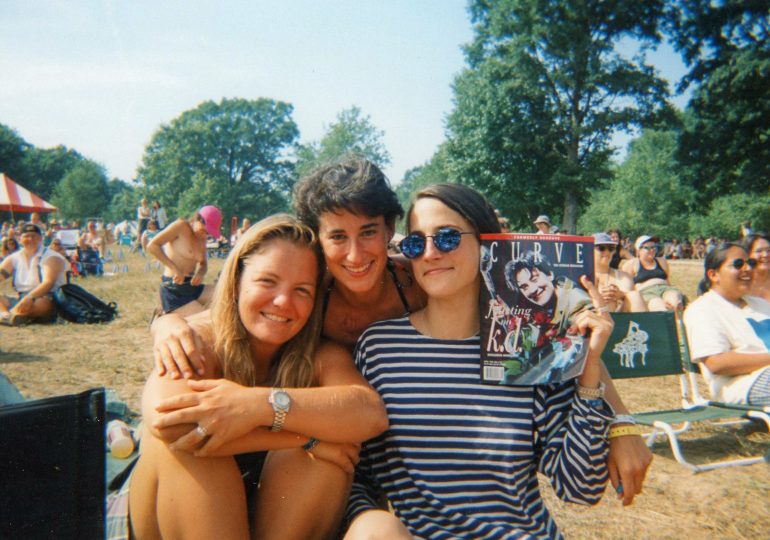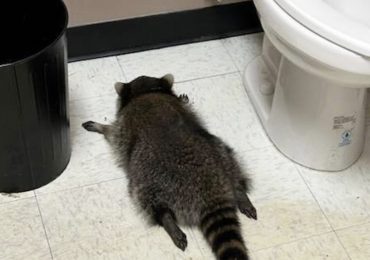Ahead of the Curve begins at what seems like the end. The documentary, which premiered in 2020 and arrived on Netflix this week, traces the legacy of the iconic lesbian and queer women’s magazine Curve and its founder, the singular Franco Stevens.
When the film opens, both the magazine and its founder are at a precipice. Curve, which Stevens had sold to an Australian publisher, is in financial trouble. “The magazine might be coming to an end,” she tells Jen Rainin, her wife and one of the film’s directors (the other is Rivkah Beth Medow). “Should it come to an end, or should it change into something else?”
[time-brightcove not-tgx=”true”]
“Do you want to be a part of figuring out what that is?” Rainin asks in response.
These questions—what can Curve be, and where will Stevens take it next?—have been at the heart of her life for decades. Stevens was only 23 in 1990 when she founded Curve, originally called Deneuve, launching the magazine with a fist full of cash she won at the races and her own face on the cover.
“In my wildest dreams, it would last for five years,” Stevens told Reuters. “After so long, to still hear women say that it saved their lives really makes it worthwhile.”
The making of Curve
Curve gave lesbians and queer women the chance to see themselves on glossy magazine pages—not just as objects of sexual intrigue or political outrage, but as fully realized people. The proud and pointed inclusion of “lesbian” on Curve’s covers was something Stevens and the rest of the magazine’s staff put a lot of thought into.
“I can’t even verbalize today how much I was ridiculed and bashed, even from within our own community by putting the word lesbian on the cover,” Stevens says in the documentary. She also worried that labeling the magazine so clearly would present a barrier for those who might want to read it, but were not yet out. At the same time, brightly branding Curve “a lesbian magazine” made its inclusion on any shelf alongside other magazines also covering lifestyle, art, and politics an unambiguous statement: we belong here.
Stevens herself was already married to a man when she learned for the first time that it was possible for a woman to be gay, in a human sexuality course she was taking in college. When she realized she was a lesbian, Stevens chose to tell her husband—only for him to unceremoniously out her to her entire family. She asked her family for help in establishing a life on her own, but was told by her mother that she “had made her bed.” Stevens continued to attend school while living in her car, and eventually got a job at gay San Francisco bookstore A Different Life. There, she found the people who helped her make the idea that would become Curve a reality.
Stevens put out a notice that she was looking for writers for a new lesbian magazine, and received hundreds of interested responses. When author and lesbian romance publisher Barbara Grier of Naiad Press sent an advertisement out to her mailing list, Stevens was inundated with more subscriptions than could fit in her mailbox. And still, in the magazine’s early years, the team struggled to fund each issue. At one point, Stevens and her girlfriend at the time stationed themselves outside bars in San Francisco’s Castro district and had the lesbian equivalent of a car-wash fundraiser, asking $20 to detail motorcycles. Much of the financial strain was due to a lack of advertising revenue—mainstream companies were afraid to be associated with a lesbian magazine.
Celebrities were similarly wary of appearing in the pages of Curve, then called Deneuve. Melissa Etheridge announced she was a lesbian during a political event in 1993, and became the first celebrity to appear on the cover. “I was so happy to be able to help the magazine, and for them to be able to help me,” she says in the film. Shortly after, the magazine landed its first ad from a major company, Budweiser. More followed suit, testing the waters and laying the groundwork for what would one day become a roaring trade of marketing to queer people (when convenient, at least) and serving as a legitimizing force.
The magazine was hitting its stride. Then in 1996, Deneuve was sued for copyright infringement by French actress Catherine Deneuve. Although Deneuve had delivered several iconic sapphic performances, Stevens insisted the magazine was not named after her. And yet, Stevens foundered under the weight of legal fees, taking out loans to keep it afloat. “The lawsuit was the most stressful time of my whole life,” she says.
A swell of support arrived in the form of the Alive and Kicking Fundraiser, which brought together artists, actors, comedians, authors from across the lesbian community to party as hard as possible in the face of an existential threat. “It was by the love of the community and the contributions of the people that performed that allowed us to keep going,” says Stevens.
The magazine was able to settle with Deneuve, and in 1996 it was re-christened Curve. “It’s a much better name,” Stevens says in the film. “A curve isn’t straight, it’s like the curves of a woman’s body. And, people can pronounce it.”
Curve began to thrive once again—but in 1997, Stevens was injured while carrying a stack of heavy boxes. She broke her foot, and though doctors initially told her it would get better, it didn’t. Instead, the pain grew worse and worse, with Stevens undergoing repeated surgeries and other treatments for nerve damage that affected both her feet. Chronic, unpredictable pain became a part of her everyday reality.
“This is why I didn’t continue to do the magazine,” Stevens explains to Rainin, holding a pair of scissors suspended above her wife’s hands. “I can’t sit here and be completely present, because of the pain. And not only the physical pain, but this anxiety of, ‘Okay, concentrate now, you never know when this is going to come down and stab you,’”—she mimes attacking Rainin’s hands with the scissors, and she flinches away. “It’s very exhausting.” Unable to work regularly, Stevens was forced to sell Curve.
Ahead of the Curve and the influence of Franco Stevens
In Ahead of the Curve, we see Stevens participate in a panel at the LGBTQ women’s media conference ClexaCon, where she asks her audience what “lesbian” means to them. For the ClexaCon crowd—and the larger community—the word has evolved since it first adorned Curve’s cover. Some in the room, especially the younger audience members, heard “lesbian” for the first time not as an identity but as a porn category. The association trans-exclusionary radical feminists have endeavored to build between their bigotry and lesbian identity has also created further distance. Others still feel deeply connected to its history, and the specificity and community it represents.
Ultimately, the moment underscores the diversity of perspectives that make up a community too often referred to monolithically. It also makes Stevens’ philosophy about the future of not only the magazine, but the lesbian community in general, clear: it will be collaborative and inclusive, and young people will lead the way.
“By being visibly queer and visibly Latinx I can hopefully make it easier for other younger folks in my family and in my community,” says advocate and scholar Andrea Pino-Silva during the panel.
One of the key points discussed by the writers, editors, artists, and activists interviewed in Ahead of the Curve is how visibility, when not coupled with support and acceptance, can be dangerous. As transgender people remind us each Trans Day of Visibility, sometimes a higher profile means a bigger target. “It was nothing to walk down the street and have somebody smack you or hit you,” says author and poet Jewelle Gomez. “Once I had a guy spit in my face.”
At the same time, visibility coupled with connection can be alchemized into community. Ahead of the Curve includes nostalgic, self-shot footage of Stevens and her contemporaries criss-crossing the country in their twenties with stacks of magazines in the trunk, visiting festivals and bars full of lesbians and queer women, all basking in the sun and in one another’s presence. Although it’s hard to imagine in the era of the internet, many people simply had no idea they could be lesbians at all. In Ahead of the Curve, members of the magazine’s original staff share letters from people all over the country, thanking Curve for introducing them to possibilities they had never envisioned for themselves.
In the years since selling Curve, Stevens has had to fight for necessary medical care, challenging California’s laws about resources allocated to those injured at work in court. This facet of her story highlights the doubled labor many disabled people face as they navigate both their professional work, and the sheer amount of administrative work it takes to secure vital accommodations and care. Today, Stevens uses a wheelchair and motorized scooter to navigate her queer coalition-building.
“It’s like I turn into everyone’s coat rack,” Stevens quips as she and Pino-Silva frame a selfie together outside the bookstore that used to house A Different Life. It’s moments like this that prove Stevens is continuing to do what she always has: making the possibilities of queer life legible, now as a visibly disabled icon of the lesbian movement. In the final shot of Ahead of the Curve, she reclines on a blanket at the park as we’ve seen her do in archival footage throughout the film, surrounded by friends and community.
In answer to the question posed at the beginning of the film—and 30 years before—Stevens founded The Curve Foundation. The Foundation awards prizes for lesbian and queer journalism, and focuses on archiving and raising awareness of lesbian history. It also continues to publish Curve—a recent issue focused on butch identity, and included an essay from Stevens herself.
“I feel lucky. Most people can spend a lifetime and still never know why they were put here on earth. I was here to create the magazine. Every time we put out a magazine it felt groundbreaking,” Stevens says. “And the work is not done.”
Leave a comment








